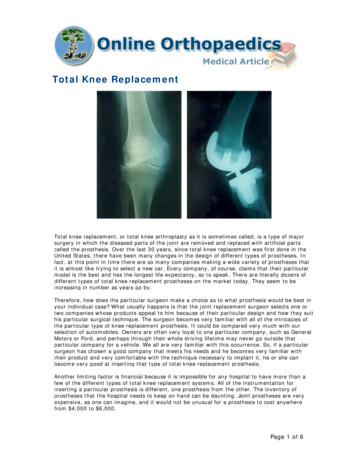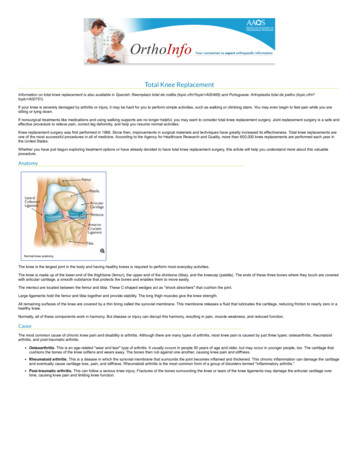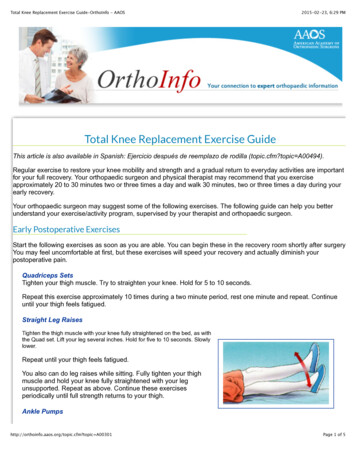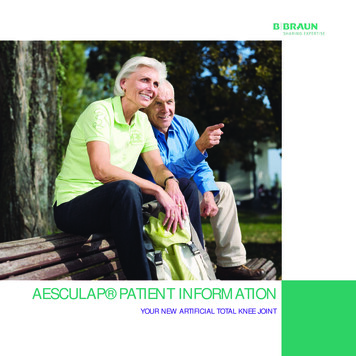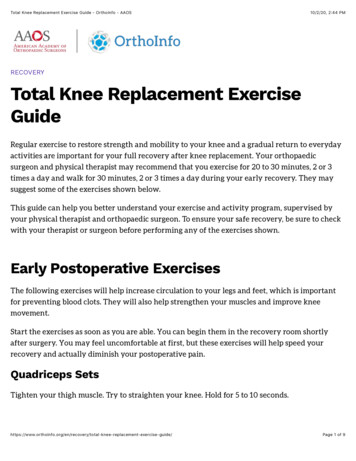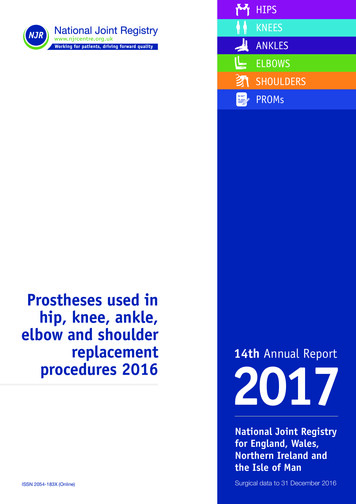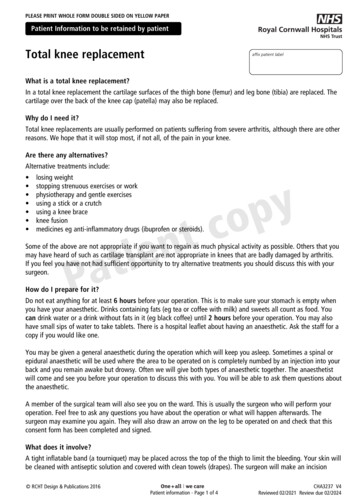
Transcription
PLEASE PRINT WHOLE FORM DOUBLE SIDED ON YELLOW PAPERPatient Information to be retained by patientTotal knee replacementaffix patient labelWhat is a total knee replacement?In a total knee replacement the cartilage surfaces of the thigh bone (femur) and leg bone (tibia) are replaced. Thecartilage over the back of the knee cap (patella) may also be replaced.Why do I need it?Total knee replacements are usually performed on patients suffering from severe arthritis, although there are otherreasons. We hope that it will stop most, if not all, of the pain in your knee.Are there any alternatives?Alternative treatments include: losing weightstopping strenuous exercises or workphysiotherapy and gentle exercisesusing a stick or a crutchusing a knee braceknee fusionmedicines eg anti-inflammatory drugs (ibuprofen or steroids).tPatneiypcoSome of the above are not appropriate if you want to regain as much physical activity as possible. Others that youmay have heard of such as cartilage transplant are not appropriate in knees that are badly damaged by arthritis.If you feel you have not had sufficient opportunity to try alternative treatments you should discuss this with yoursurgeon.How do I prepare for it?Do not eat anything for at least 6 hours before your operation. This is to make sure your stomach is empty whenyou have your anaesthetic. Drinks containing fats (eg tea or coffee with milk) and sweets all count as food. Youcan drink water or a drink without fats in it (eg black coffee) until 2 hours before your operation. You may alsohave small sips of water to take tablets. There is a hospital leaflet about having an anaesthetic. Ask the staff for acopy if you would like one.You may be given a general anaesthetic during the operation which will keep you asleep. Sometimes a spinal orepidural anaesthetic will be used where the area to be operated on is completely numbed by an injection into yourback and you remain awake but drowsy. Often we will give both types of anaesthetic together. The anaesthetistwill come and see you before your operation to discuss this with you. You will be able to ask them questions aboutthe anaesthetic.A member of the surgical team will also see you on the ward. This is usually the surgeon who will perform youroperation. Feel free to ask any questions you have about the operation or what will happen afterwards. Thesurgeon may examine you again. They will also draw an arrow on the leg to be operated on and check that thisconsent form has been completed and signed.What does it involve?A tight inflatable band (a tourniquet) may be placed across the top of the thigh to limit the bleeding. Your skin willbe cleaned with antiseptic solution and covered with clean towels (drapes). The surgeon will make an incision RCHT Design & Publications 2016Patient information - Page 1 of 4CHA3237 V4Reviewed 02/2021 Review due 02/2024
Total knee replacementPatient Information to be retained by patient(a cut) down the middle of the knee. The knee capsule (the tough, gristle-like tissue around the knee) which is thenvisible can be cut and the knee cap (patella) moved to one side. From here, the surgeon can trim the ends of thethigh bone (femur) and leg bone (tibia) using a special bone saw. Sometimes it may be necessary to remove theunderside of the knee cap.Using measuring devices a new metal surface is fitted to the end of the thigh bone (femur). This is shaped a littlelike the original joint. A metal plate or tray is fitted to the top of the leg bone (tibia). A bearing made from a veryspecial plastic, sits between the two surfaces. The cartilage on the underside of the knee cap may be replaced withthe same material.When the surgeon is happy with the position and movements of the knee, the tissue and skin can be closed. Thismay be done with stitches (sutures) or metal clips (skin staples). The clips and stitches may need to be removedaround 10 days after the operation. Sometimes absorbable stitches are used. A collecting bottle or drain connectedto the knee by a small tube may be used to remove any blood that collects in the artificial joint. This can be pulledout easily on the ward after a day or two.yopWhen you wake up, you will have a padded bandage around the knee. It is important at every stage to let the staffknow if you have pain and to ask for painkillers if you need them. You will be encouraged to start walking as soonas possible with the aid of the physiotherapists. You will go for an X-ray a day or so after the operation.cntPlease be aware that a surgeon other than your consultant, but with adequate training or supervision may performyour operation.eiatWhat happens afterwards?PYou will normally spend a few days in hospital. Before you go home, the nursing staff and therapists will want tobe sure that you are well enough and that the conditions at home are such that you can manage safely.The physiotherapists will give advice about exercises to perform and how to manage particular activities such asstairs. It is important to follow their instructions in order to get the best possible range of movement from yournew knee. There is a separate sheet showing these exercises, to take with you.You should avoid certain activities during the first 6 weeks after surgery: driving sitting or standing for long periods without moving the knee.To reach your maximum level of comfort and function may take up to a year. Many patients feel that they are morecomfortable than before the operation at around 6-8 weeks but this varies.What should I look out for?Further information can be viewed on the patient information pages at www.orthoconsent.comTo reach your maximum level of comfort and function may take up to a year. Many patients feel that they are morecomfortable than before the operation at around 6-8 weeks but this varies.Are there any risks or complications?As with all procedures, there are risks from having this operation:Common (Happens in 2-5% of patients)Pain: Your knee will be sore after the operation. If you are in pain, it’s important to tell staff so that medicines canbe given. Pain will improve with time. Rarely, pain will be a chronic problem and may be due to any of the othercomplications listed below, or for no obvious reason. Some replaced knees can remain persistently painful despitesurgery.Patient information - Page 2 of 4
Total knee replacementPatient Information to be retained by patientBleeding: This is usually minor and is stopped during the operation. Around 1 in 10 patients need a bloodtransfusion and some will need iron tablets. Rarely, the bleeding may form a blood clot or large bruise within thewound which may become painful and require an operation to remove.Blood clots: Blood clots can form in the veins after surgery. This is known as Deep Vein Thrombosis or DVT.These can cause painful swelling of the leg and very rarely, put your life at risk by affecting your lungs. We willgive you medicine to reduce this risk. Some surgeons will also ask you to wear stockings on your legs, while othersmay use foot pumps to keep blood circulating around the leg. Starting to walk and getting moving is one of thebest ways to prevent blood clots from forming.Implant wear and loosening: With modern operating techniques and implants, we expect knee replacements to lastover 15 years. In some cases, they fail early. The reason is often unknown. It may be a result of your body’sresponse to the implant, the implant itself or your level of activity. All the implants used at the Royal CornwallHospital use tried and tested materials but there is no perfect knee replacement. Feel free to discuss the type ofimplant that will be used, with your surgeon.ypcoKnee stiffness: May occur after the operation, especially if the knee is stiff before the surgery. Manipulation of thejoint (under general anaesthetic) may be necessary.Numbness over the front of the knee: It is common to have some numbness over the front of the knee on bothsides of the scar. This is normally permanent.tneitDifficulty kneeling: Many patients have difficulty kneeling after knee replacement because it can feel unpleasant.There is no reason not to kneel after knee replacement if you find it comfortable.PaLess common: (1-2%)Infection: To minimise the risk of infection, you will be given antibiotics before surgery, ultra clean air theatres willbe used and special precautions taken by the theatre staff with gowning and draping. Despite this infections canstill occur. The wound site may become red, hot and painful. There may also be a discharge of fluid or pus. Ifcaught early, this can often be treated with antibiotics and an operation to wash the joint out. If caught late or ifthe infection is severe the implants may need to be removed and replaced at a later date. The infection cansometimes lead to sepsis (blood infection) requiring strong intravenous (IV) or long term antibiotics.It is vital that you tell medical staff if you think you have an infection at any stage.Rare: ( 1%)Altered leg length: The leg which has been operated upon, may appear shorter or longer than the other.Altered wound healing: The wound may become red, thickened and painful (keloid scar) especially in AfroCaribbeans.Joint dislocation: If this occurs, the joint can usually be put back into place without the need for surgery.Sometimes this is not possible, and an operation is required, followed by application of a knee brace.Nerve damage: Every effort is made to avoid this; however damage to the nerves around the knee can occur. Thismay cause temporary or permanent changes in the feeling of the leg or the strength of the leg muscles, particularlythose around the ankle.Bone damage: The thigh bone may be broken when the implant (metal replacement) is put in. This may requirefixation, either at the time or at a later operation.Patient information - Page 3 of 4
Total knee replacementPatient Information to be retained by patientBlood vessel damage: Rarely, the vessels around the knee may be damaged. This may require further surgery bythe vascular surgeons.Pulmonary Embolism: A PE is a consequence of a DVT. It is a blood clot that spreads to the lungs and can makebreathing very difficult. A PE can be fatal.Risk from the anaesthetic: The risk to a healthy person of problems arising from an anaesthetic is very small.However each year in the UK several healthy people will die or suffer serious heart, lung or brain injury followingan anaesthetic. This can be from problems or mistakes made during the anaesthetic or because of patient healthproblems. We will always take every possible step to keep you safe during your operation.tneitPaypcoIf you would like this leaflet in large print, Braille, audio version or in another language,please contact the General Office on 01872 252690Patient information - Page 4 of 4
Patient copyCONSENT FORM 1PROCEDURE SPECIFIC PATIENT AGREEMENTNHS number:Name of patient:sideIENTX PATAddress:Date of birth:Total knee replacementLLABEAFFICR number:Replacing the cartilage surfaces of the thigh bone (femur) and leg bone (tibia). The cartilage over the back of the kneecap (patella) may also be replaced.STATEMENT OF HEALTH PROFESSIONAL (to be filled in by health professional with appropriate knowledge ofproposed procedure, as specified in consent policy)I have explained the procedure to the patient. In particular, I have explained the intended benefits andsummarised the risks, as below: We hope to stop most, if not all, of the pain in your kneeypcoSignificant, unavoidable or frequently occurring risks: Blood clots, bleeding, pain, implant wear and loosening, altered leg length, joint dislocation, stiffnesstneitUncommon but more serious risks: Infection sometimes requiring further surgery, strong IV or long term antibioticsRare but serious risks: PaAltered wound healing, nerve damage, bone damage, blood vessel damage, pulmonary embolism, riskto life Anaesthetic risk which includes a very small risk to life or limb from complications such as heartattack and strokeAny extra procedures which may become necessary during the procedure: Blood transfusion (rarely necessary) Other (please specify):I have also discussed what the procedure is likely to involve, the benefits and risks of any availablealternative treatments (including no treatment) and any particular concerns of this patient.I have given and discussed the Trust’s approved patient information leaflet for this procedure: Totalknee replacement CHA3237 which forms part of this document.I am satisfied that this patient has the capacity to consent to the procedure.This procedure will involve:General and/or regional anaesthesiaHealth Professional signature:Local anaesthesiaSedationDate:Name (PRINT):Job title:STATEMENT OF INTERPRETER (where appropriate)I have interpreted the information above to the patient to the best of my ability and in a way in which I believehe/she can understand.Interpreter signature:Name (PRINT):Consent Form (Patient copy) - Page 1 of 2Date:CHA3237 V4Reviewed 02/2021 Review due 02/2024
Patient copyTotal knee replacementconsentaffix patient labelSTATEMENT OF PATIENTPlease read this form carefully. If your treatment has been planned in advance, you should already have a copyof the patient information leaflet which describes the benefits and risks of the proposed treatment. If not, youwill be given a copy now. If you have any further questions, do ask - we are here to help you. You have the rightto change your mind at any time, including after you have signed this form.I agree to the procedure or course of treatment described on this form.I understand that you cannot give me a guarantee that a particular person will perform the procedure. Theperson will, however, have appropriate experience.I understand that I will have the opportunity to discuss the details of anaesthesia with an anaesthetist beforethe procedure, unless the urgency of my situation prevents this. (This only applies to patients having general orregional anaesthesia).yopctnI understand that any procedure in addition to those described on this form will only be carried out if it isnecessary to save my life or to prevent serious harm to my health.I understand that tissue samples will only be taken in relation to the procedure explained to me. No sampleswill be taken for quality control, clinical education or research purposes.eiatI have been told about additional procedures which may become necessary during my treatment. I have listedbelow any procedures which I do not wish to be carried out without further discussion.PI have received a copy of the Consent Form and Patient Information leaflet: Total knee replacementCHA3237 which forms part of this document.Patient signature:Name (PRINT):Date:A witness should sign below if this patient is unable to sign but has indicated his or her consent.Young people / children may also like a parent to sign here (see guidance notes).Witness signature:Name (PRINT):Date:CONFIRMATION OF CONSENT (to be completed by health professional when the patient is admitted for theprocedure, if the patient has signed the form in advance).On behalf of the team treating the patient, I have confirmed with the patient that they have no further questionsand wish the procedure to go ahead.Health Professional signature:Date:Name (PRINT):Job title:Important notes (tick if applicable):See advance decision to refuse treatmentPatient signature:Patient has withdrawn consent (ask patient to sign/date here)Name (PRINT):Consent Form (Patient copy) - Page 2 of 2Date:
Filed within Legal SectionCONSENT FORM 1PROCEDURE SPECIFIC PATIENT AGREEMENTNHS number:Name of patient:sideIENTX PATAddress:Date of birth:Total knee replacementLLABEAFFICR number:Replacing the cartilage surfaces of the thigh bone (femur) and leg bone (tibia). The cartilage over the back of the kneecap (patella) may also be replaced.STATEMENT OF HEALTH PROFESSIONAL (to be filled in by health professional with appropriate knowledge ofproposed procedure, as specified in consent policy)I have explained the procedure to the patient. In particular, I have explained the intended benefits andsummarised the risks, as below: We hope to stop most, if not all, of the pain in your kneeSignificant, unavoidable or frequently occurring risks: Blood clots, bleeding, pain, implant wear and loosening, altered leg length, joint dislocation, stiffnessUncommon but more serious risks: ypcoInfection sometimes requiring further surgery, strong IV or long term antibioticsRare but serious risks: eliFAltered wound healing, nerve damage, bone damage, blood vessel damage, pulmonary embolism, riskto life Anaesthetic risk which includes a very small risk to life or limb from complications such as heartattack and strokeAny extra procedures which may become necessary during the procedure: Blood transfusion (rarely necessary) Other (please specify):I have also discussed what the procedure is likely to involve, the benefits and risks of any availablealternative treatments (including no treatment) and any particular concerns of this patient.I have given and discussed the Trust’s approved patient information leaflet for this procedure: Totalknee replacement CHA3237 which forms part of this document.I am satisfied that this patient has the capacity to consent to the procedure.This procedure will involve:General and/or regional anaesthesiaHealth Professional signature:Local anaesthesiaSedationDate:Name (PRINT):Job title:STATEMENT OF INTERPRETER (where appropriate)I have interpreted the information above to the patient to the best of my ability and in a way in which I believehe/she can understand.Interpreter signature:Name (PRINT):Consent Form (File copy) - Page 1 of 2Date:CHA3237 V4Reviewed 02/2021 Review due 02/2024
File copyTotal knee replacementconsentaffix patient labelSTATEMENT OF PATIENTPlease read this form carefully. If your treatment has been planned in advance, you should already have a copyof the patient information leaflet which describes the benefits and risks of the proposed treatment. If not, youwill be given a copy now. If you have any further questions, do ask - we are here to help you. You have the rightto change your mind at any time, including after you have signed this form.I agree to the procedure or course of treatment described on this form.I understand that you cannot give me a guarantee that a particular person will perform the procedure. Theperson will, however, have appropriate experience.I understand that I will have the opportunity to discuss the details of anaesthesia with an anaesthetist beforethe procedure, unless the urgency of my situation prevents this. (This only applies to patients having general orregional anaesthesia).ypcoI understand that any procedure in addition to those described on this form will only be carried out if it isnecessary to save my life or to prevent serious harm to my health.I understand that tissue samples will only be taken in relation to the procedure explained to me. No sampleswill be taken for quality control, clinical education or research purposes.eliFI have been told about additional procedures which may become necessary during my treatment. I have listedbelow any procedures which I do not wish to be carried out without further discussion.I have received a copy of the Consent Form and Patient Information leaflet: Total knee replacementCHA3237 which forms part of this document.Patient signature:Name (PRINT):Date:A witness should sign below if this patient is unable to sign but has indicated his or her consent.Young people / children may also like a parent to sign here (see guidance notes).Witness signature:Name (PRINT):Date:CONFIRMATION OF CONSENT (to be completed by health professional when the patient is admitted for theprocedure, if the patient has signed the form in advance).On behalf of the team treating the patient, I have confirmed with the patient that they have no further questionsand wish the procedure to go ahead.Health Professional signature:Date:Name (PRINT):Job title:Important notes (tick if applicable):See advance decision to refuse treatmentPatient signature:Patient has withdrawn consent (ask patient to sign/date here)Name (PRINT):Consent Form (File copy) - Page 2 of 2Date:
In a total knee replacement the cartilage surfaces of the thigh bone (femur) and leg bone (tibia) are replaced. The. cartilage over the back of the knee cap (patella) may also be replaced. Why do I need it? Total knee replacements are usually performed on patients suffering from severe arthritis, although there are other. reasons. We hope that .
